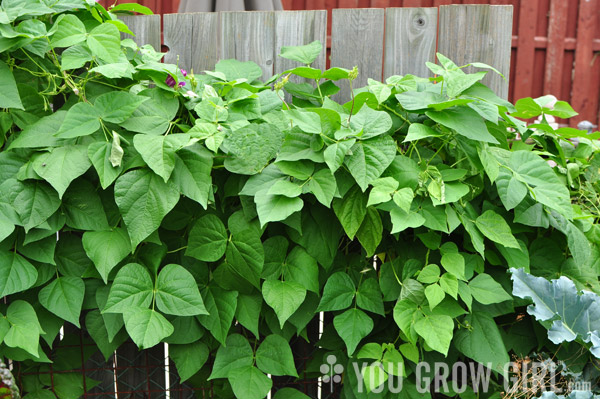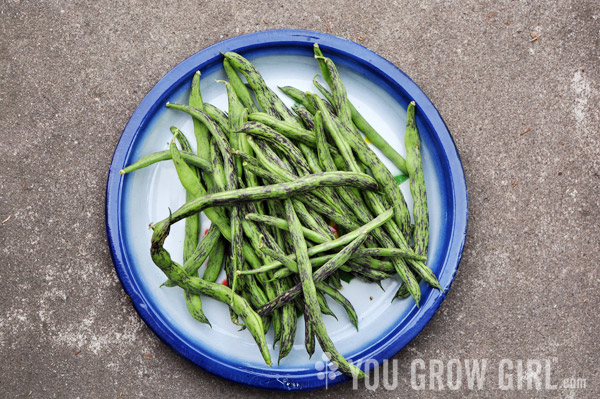
I have two criteria when choosing beans (Phaseolus vulgaris) to grow: they must be delicious at the tender, green bean (aka snap bean) stage and they must have something about them that is aesthetically pleasing. Over the years I have experimented with a lot of bean varieties and by these criteria ‘Trionfo Violetto’ and ‘Royal Burgundy’ have remained the reigning pole and bush bean (respectively) in my garden for some time.

In my current garden, I use two old, metal bedsprings as support for pole beans. A friend picked them up for me free on the curb. I train the vines along the frame and they act as a living fence between my yard and the neighbour’s. I have grown peas here as well.
A few years back, when I first moved to my current home and garden, my friend Margaret (of A Way to Garden) sent me a few little containers of ‘Rattlesnake’ aka ‘Preacher,’ a pretty, splashed and patterned pole bean that she had saved from her own garden. Margaret had nothing but praise for this variety, but I was hesitant to give over precious space to something new. Eventually, I decided to cut my planting of ‘Trionfo Violetto’ in half, and sacrificed the rest to this new bean. She was right! It turned out to be a wonderful and prolific producer. Since then I have grown a little of both varieties each year. I appreciate having both colours in my harvest basket, and two different flavours on my plate. In fact, ‘Rattlesnake’ has turned out to be the more dependable of the two. Last summer was unseasonably cold and wet. ‘Trionfo Violetto’ and a few other pole beans had a difficult time getting off the ground and their poor health made them targets for a particularly large population of slugs. The plants stayed stunted for weeks and by the time the heat picked up they were too far behind to produce well. However, ‘Rattlesnake’ soldiered on and came through when the others didn’t.

The Details:
For more about growing beans see this article as well as the section in my book, Grow Great Grub (pages 82-84 if you have a copy).
- Open-pollinated/heirloom.
- About 60-90 days to harvest.
- Green pods, streaked with purple. Lose their colour when cooked.
- Pole bean that can grow up to 10 feet vines. Some drought-resistance.
- Soak beans overnight in your choice of water, compost tea, or sea kelp.
- To increase yields, dip in Rhizobia bacteria inoculant before planting. This can be especially useful in new gardens and cool seasons.
- Direct sow into the soil or very deep containers after all danger of frost has passed.
- Beans are sensitive to cold, wet soil. I typically wait until early June here in Toronto and shift my start dates based on the forecast.
- Plants will require support. I often favour a tripod form made of the tallest bamboo poles I can find. In my current garden I also use an old metal bed spring.
- Grow in full sun in well-draining soil.
- Allow pods to fully mature and dry on the vine before harvesting for seed.
- Container Growing: I generally prefer bush bean varieties in pots, but recommend a container that is at least 16″ deep.
‘Rattlesnake’ is a popular variety and many vendors sell them. I recommend High Mowing or Seed Savers.
I also grow Trionfo Violetto – it’s a favorite. And I can’t think of the name right now, but there’s an Italian yellow pole bean I grow as well. The newest bean in my collection that I’m growing this year is Cherokee Trail of Tears, primarily for the bry beans.
I managed to find these at the Seedy Sunday in North York last weekend!
I really enjoyed reading this post, it looks fantastic! I’ve never heard of rattlesnake beans, they look great along the fence.
Your blog has some great ideas and its full of inspiration for growing your own vegetables at home. Plus its very easy to navigate around, and you have a number of great links and a great ”garden tips” section.
Looking forward to more pictures on the progress of the rattlesnake beans. Keep it up!
Haleh, Perth, Western Australia.